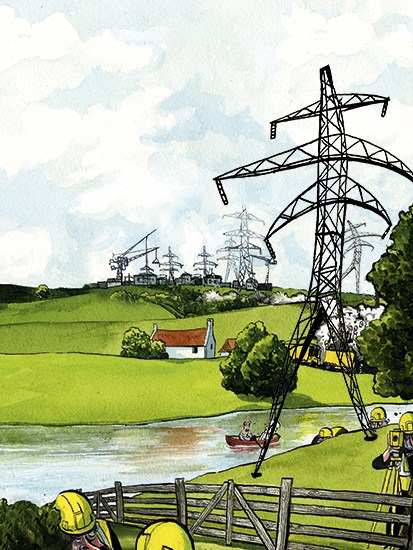Listen
There is no such thing as the English countryside. There is my countryside, your countryside and everyone else’s. Most people fight just for theirs. When David Cameron told the BBC’s Countryfile he would defend the countryside ‘as I would my own family’, many of its defenders wondered which one he meant. In the past five years a national asset that public opinion ranks with the royal family, Shakespeare and the NHS, has slid into trench warfare. Parish churches fill with protest groups. Websites seethe with fury. Planning lawyers have never been busier. The culprit has been planning reform.
My files burst with reports from the front, each local but collectively a systematic assault on the appearance of rural England. In Gloucestershire, Berkeley Castle gazes across the vale of the Severn to the Cotswolds as it has since the middle ages. It is now to face fields of executive homes. Thamesside Cookham is to be flooded not by the river but by 3,750 houses. The walls of Warwick Castle are to look out over 900 houses. The ancient town of Sherborne must take 800.
So-called ‘volume estates’ — hundreds of uniform properties rather than piecemeal growth — are to suburbanise towns and villages such as Tewkesbury, Tetbury, Malmesbury, Thaxted, Newmarket, Great Coxwell, Uffington, Kemble, Penshurst, Hook Norton, Stow-on-the-Wold, Mevagissey, Formby. Every village in Oxfordshire has been told to add a third more buildings. Needless to say there is no local option.
Developer lobbyists and coalition ministers jeer at those who defend what they regard as ‘chocolate-box England’. But did Cameron mean so radically to change the character of the English village and country town? These are not just chocolate boxes. The list embraces the country round Durham, Gateshead, Rotherham, Salford, Redditch, Lincoln and Sandbach. Such building will ‘hollow out’ town centres. Three-quarters of hypermarket approvals are now out of town, even as this market collapses. The green belt is near meaningless. The Campaign to Protect Rural England estimates some 80,000 units are now proposed for greenbelt land.
The coalition’s planning policy was drafted in 2011 by Local Government Secretary Eric Pickles’s ‘practitioner advisory group’. This group is a builders’ ramp, composed of Taylor Wimpey and others. Councils were told that either they could plan for more building or it would proceed anyway. Brownfield preference was ended. Journey-to-work times were disregarded. Fields could sprout unregulated billboards. ‘Sustainable’ development was defined as economic, then profitable.
The draft proved so bad it had to be amended. But the disregard of local wishes and bias against rural conservation remained. As with siting of wind and solar installations, the centre knew best. Whereas 80 per cent of new building before 2010 had been on serviced land within settlements, this has now shrunk to half.
The most successful tactic of the rural developers was the hijacking of ‘the housing crisis’. They claimed the crisis could only be ended by building in open country, even when their wish was for ‘executive homes’. This ideal of land lying enticingly ‘free’ for homeless people acquired the moral potency of the NHS.
Housing makes politicians go soft in the head. An old Whitehall saw holds that England ‘needs’ 250,000 new houses a year, because that is how many households are ‘formed’. The figure, a hangover from wartime predict-and-provide, takes no account of occupancy rates, geography of demand, migration or housing subsidy, let alone price. Everyone thinks they ‘need’ a better house.
Yet this figure has come to drive a thousand bulldozers and give macho force to ideologues of left and right, whose ‘own’ countryside is somewhere in France or Italy. Few Britons are homeless. Most enjoy living space of which the Japanese can only dream. Yet the Economist magazine cites the 250,000 figure at every turn. The Institute of Economic Affairs wails that housing has become ‘unaffordable for young people’. A recent FT article declared, ‘The solution to the housing crisis lies in the green belt.’
This is all nonsense. The chief determinant of house prices is wealth, subsidy and the supply of money. During the credit boom, prices soared in America and Australia, where supply was unconstrained. Less than 10 per cent of Britain’s housing market is in new building. Although clearly it is a good thing if more houses are available, there is no historical correlation between new builds and price.
Neil Monnery’s Safe as Houses is one of the few sane books on housing economics. It points out that German house prices have actually fallen over half a century of steady economic boom. The reason is that just 43 per cent of Germans own their own homes, and rarely do so under the age of 40. The British figure hovers between 60 and 80 per cent. Germans are content to rent, a more efficient way of allocating living space. They invest their life savings elsewhere, much to the benefit of their economy.
The curse of British housing, as another economist, Danny Dorling, has written, is not under-supply but under-occupancy. In half a century, Britons have gone from ‘needing’ 1.5 rooms each to needing 2.5 rooms each. This is partly caused by tax inducements to use houses as pension funds, partly by low property taxes and high stamp duty on transfers. Britain, Dorling says, has plenty of houses. It just uses them inefficiently, though high prices are now at last shifting the market back to renting.
London’s housing has been ‘in crisis’ for as long as I can remember. Yet its under-occupancy is remarkable. Famously its annual growth could fit into the borough of Ealing if it was developed at the density of inner Paris. The agents Stirling Ackroyd have identified space in the capital for 500,000 new houses without encroaching on its green belt. The reality is that housing ‘need’ (that is, demand) is never met in booming cities, only in declining ones.
This has nothing to do with building in the countryside. Past policies aimed at ‘out-of-town’ new towns and garden cities merely depopulated cities and duplicated infrastructure. Central Liverpool and Manchester (like Shoreditch) numbered their voters in hundreds rather than tens of thousands. A rare architect wise to these things, Lord Rogers, recently wrote that this led to ‘new town blues, lifeless dormitories, hollowed-out towns and unnecessary encroachment on green sites’. Sprawl was about profit, not planning.
The answer to housing a rising population has to lie in towns and cities, in reducing the pressure on commuting and raising the efficiency of infrastructure. Cities are where people and jobs are, and where services can be efficiently supplied. England’s urban population per acre is low by world standards, half that of New York or Paris, yet even so its housing occupancy is low. A boost to urban densities — not just empty towers along the Thames — is a sensible ‘green’ policy.
England’s countryside will clearly change over time. Its occupants no longer farm it, and are more often retired or commuters. Yet its amenity is clearly loved by the mass of people who visit, enjoy, walk and play in it. Its beauty in all weathers remains a delight of living and moving about in this country. England made a mess of its cities after the war. The rural landscape is its finest environmental asset.
Any civilised society regulates the market in scarce resources, including those of beauty. It guards old paintings, fine buildings, picturesque villages, mountains and coasts. England is the most crowded of Europe’s big countries, yet a past genius for policing the boundary between town and country has kept 80 per cent of its surface area still visually rural in character. This has been crucially assisted by the 14 urban green belts created in the 1950s by a Conservative, Duncan Sandys.
I am sure the way forward is to treat the countryside as we do urban land. It should be listed and conserved for its scenic value — as it is for its quality as farmland. I would guess this would render sacrosanct a ‘grade one’ list of roughly three quarters of rural England, to be built on only in extremity. The remaining grades would enjoy the protection of a ‘presumption against development’, but a protection that would dwindle down the grades to ‘of limited local value’.
One feature of such listing is that green belts could be redefined. Those of minimal amenity value would be released in favour of belt extension elsewhere. It is stupid to guard a muddy suburban field while building over the flanks of the Pennines.
In making these judgments we need to rediscover the language of landscape beauty, fashioned by the sadly deceased Oliver Rackham and others. Without such language, argument is debased and money rules. The policy of ‘let rip’, adopted by both major parties at present, means that England’s countryside is having to fight for each wood and field alone. At which point I say, praise be for nimbys.
Got something to add? Join the discussion and comment below.
Get 10 issues for just $10
Subscribe to The Spectator Australia today for the next 10 magazine issues, plus full online access, for just $10.
You might disagree with half of it, but you’ll enjoy reading all of it. Try your first month for free, then just $2 a week for the remainder of your first year.














Comments
Don't miss out
Join the conversation with other Spectator Australia readers. Subscribe to leave a comment.
SUBSCRIBEAlready a subscriber? Log in